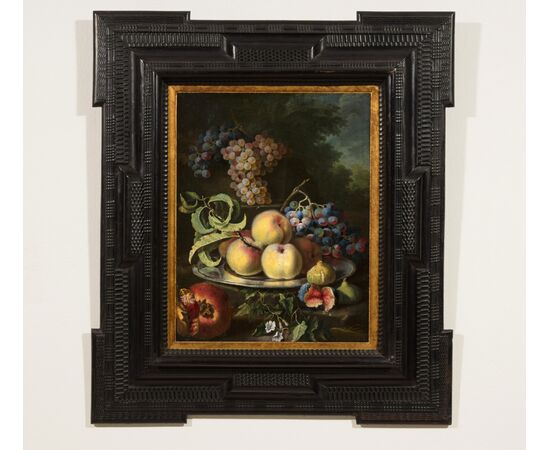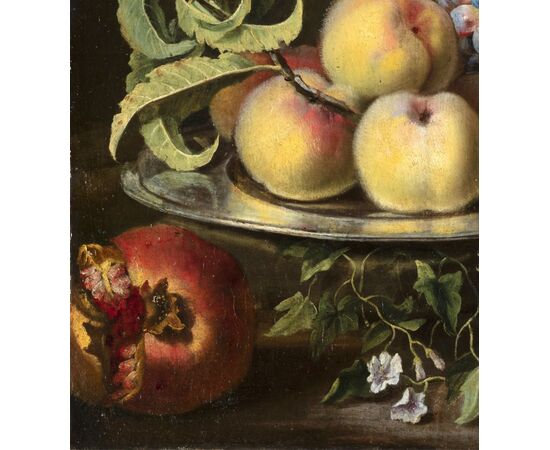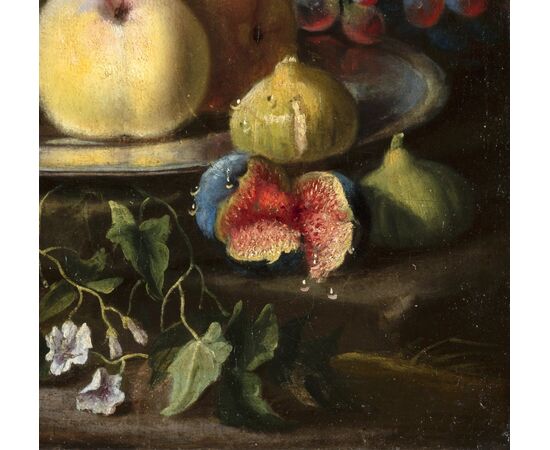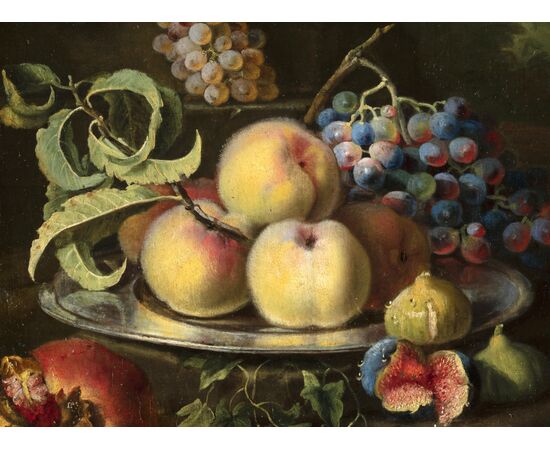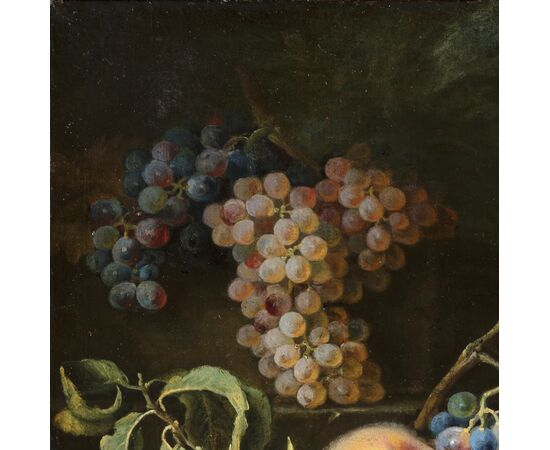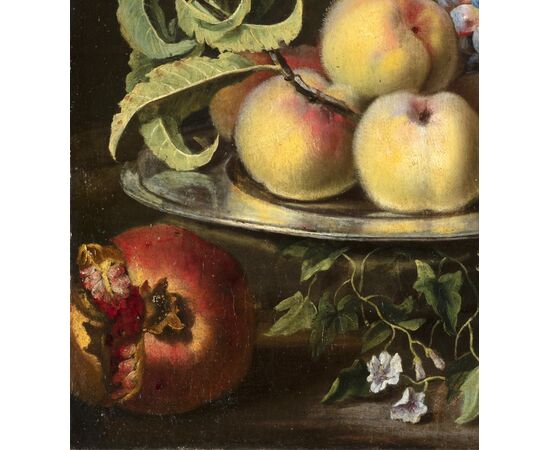Maximilian Pfeiler (documented from 1694 to 1721), Still life with peaches, grapes, figs and pomegranate, oil on canvas
Maximilian Pfeiler (documented from 1694 to 1721)
Still life with peaches, grapes, figs and pomegranate
Oil on canvas, cm H 63.5 x W 47. With frame cm H 97.5 x W 85 x D 7.5
Price upon private negotiation
Object accompanied by a certificate of authenticity and expertise (downloadable at the bottom of the page)
The canvas, of exquisite workmanship, depicts a still life composed of a splendid composition of fruit set in an outdoor space, of which we see some elements appearing in the background. At the center of the canvas are arranged, on a silver plate, peaches, figs, and grapes. In the background, lying on stone steps, is depicted a rich bunch of white grapes, behind which lush tree fronds form the background and backdrop to the composition. In the foreground, next to the figs, are white climbing bellflowers. On the right, a pomegranate is depicted partially, as if partially hidden by the frame, a device useful to the painter to liven up the composition and involve the observer as if he were part of the depicted environment.
The work can undoubtedly be attributed to the still life painter Maximilian Pfeiler, active in Rome in the early eighteenth century in the orbit of Christian Berentz (Hamburg 1658- Rome 1722) and documented from 1694 to 1721. Few documents relating to his training and his life and artistic career are available. However, Gianluca Bocchi and Ulisse Bocchi in 2000 trace a precise examination of his certain works and those that can be returned, with reasonable certainty, to his corpus of works. What emerges is the artist's inclination to propose representations of naturalia with a decorative appearance supported by a talented pictorial rendering expressed with "free and loose pictorial discourse". His artistic personality manifests itself autonomously, although he demonstrates knowledge of the Roman layout used by other contemporary painters. The attendance of the great master Christian Berentz represented a fundamental stage in Pfeiler's training, capable of motivating the refinement of his works and the scenographic and capricious compositions of the mature period. According to a tradition of still life painters, he used cardboard prearranged in the workshop, re-proposing in his canvases typical and characterizing elements.
The painting presented here brings together many of the motifs experimented by Pfeiler during his successful activity. Some of them - figs and other fruits reflected on a silver plate; reddish peaches with long curled leaves; the sliced melon placed on a tray, the embroidered tablecloth - derive from the models of his first master, which Pfeiler includes in his repertoire, combining them tirelessly in increasingly exuberant compositions, typical of the decorative instances of late-baroque still life.
The work in question can be traced back to a corpus of small-format works commissioned for Roman bourgeois salons.
For the variety of motifs and the quality with which they were made, this painting is particularly close to a painting present in a private collection, and placed here below for comparison, in which we find the same characterizing elements and a completely similar composition. In the comparison between the two canvases, some variations are noted, such as the lemons in the foreground, a pear among the bellflowers and a leaf positioned in place of a fig. In the background, behind the bunch of black grapes, the painter inserts a pomegranate.
In his more mature production, Maximilian Pfeiler creates highly complex and rich compositions, in which he inserts putti, carpets, crystals and opulent sets of flowers and fruit. Following a fashion that was very popular in Rome in the second decade of the eighteenth century, the artist collaborates with figurative artists for the creation of large decorative canvases. Among these we mention the paintings of Count von Schönborn in Pommersfelden, where the putti are by Francesco Trevisani and the paintings dated 1721 in the Budapest museum in which Michele Rocca collaborated instead.
The Zeri Photo Library preserves an image of a very similar painting, classified by Federico Zeri as a work attributable to Christian Berentz or to a painter active in Rome in his circle. The photographic archive indicates as the last provenance of the work the Stefano Bardini Museum in Florence, belonging to the Corsi collection.
Maximilian Pfeiler acquires over time a particular technical skill and we can today consider him a late Baroque painter "free, loose, exuberant and elegant, endowed with a verve of pure Roman style, grafted onto chiaroscuro systems, able to achieve results of absolute decorative excellence" (Bocchi, 2000).
The work is presented with a coeval guilloché frame made of ebonized wood.
Carlotta Venegoni

